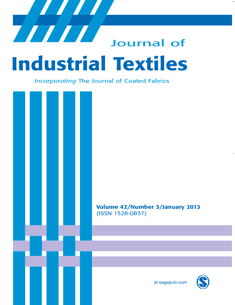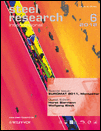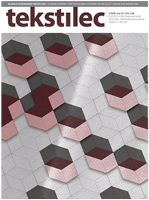
NORDIC PULP & PAPER RESEARCH JOURNAL
Scope & Guideline
Driving Impact Through Cutting-Edge Research
Introduction
Aims and Scopes
- Pulp Production and Processing:
Research dedicated to the methods of producing pulp from various sources, including mechanical and chemical processes, along with innovations in refining and bleaching techniques. - Sustainable Materials and Applications:
Exploration of biobased materials and sustainable practices in paper production, including the use of alternative fibers, bio-fillers, and coatings that enhance the environmental performance of paper products. - Chemical and Physical Properties of Paper:
Studies focusing on the mechanical, thermal, and barrier properties of paper and paperboard, including the effects of various additives and processing conditions. - Waste Management and Recycling:
Investigations into the treatment of waste generated during pulp and paper production, as well as the recycling processes and the quality of recycled fibers. - Innovative Coating and Functionalization:
Development of novel coatings and functionalization techniques to improve the usability of paper products in various applications, including food packaging and active packaging technologies.
Trending and Emerging
- Nanotechnology in Pulp and Paper:
The application of nanomaterials, such as nanocellulose and graphene, is increasingly featured, showcasing their potential to enhance the properties of paper and packaging materials. - Bio-based and Eco-friendly Additives:
There is a growing focus on the use of biobased additives and coatings that improve the sustainability of paper products, aligning with global trends towards reducing plastic usage and enhancing recyclability. - Digitalization and Process Optimization:
The integration of digital technologies, including machine learning and artificial intelligence for process optimization in pulp production and quality control, is emerging as a significant theme in recent research. - Circular Economy Practices:
Research emphasizing the circular economy principles in the pulp and paper industry is gaining momentum, focusing on waste reduction, resource reuse, and lifecycle assessments. - Advanced Characterization Techniques:
Innovative methods for characterizing paper properties, including advanced imaging and modeling techniques, are increasingly being explored, reflecting a trend towards more sophisticated analysis.
Declining or Waning
- Traditional Bleaching Methods:
Research related to conventional bleaching processes is becoming less prevalent as the industry shifts towards more sustainable and environmentally friendly alternatives, such as enzymatic and biobleaching. - Basic Mechanical Properties Testing:
While understanding the mechanical properties of paper remains important, there has been a decline in studies that solely focus on basic mechanical testing, as researchers increasingly seek to integrate these findings with advanced modeling and simulation techniques. - Single-Fiber Studies:
There has been a notable decrease in studies focused exclusively on single-fiber behavior, as the trend moves towards more complex analyses involving fiber networks and composite materials.
Similar Journals

Russian Journal of Non-Ferrous Metals
Fostering Excellence in Materials ResearchThe Russian Journal of Non-Ferrous Metals, published by PLEIADES PUBLISHING INC, serves as a vital resource for researchers and professionals in the fields of materials science and engineering. With a dual ISSN (1067-8212 for print and 1934-970X for online), this journal has been instrumental in disseminating cutting-edge research from 2007 to 2023. Specializing in the mechanics of materials, metals and alloys, and the study of surfaces, coatings, and films, it provides invaluable insights into the latest advancements and applications in these areas. Although currently categorized in the Q4 tier for mechanics of materials and surfaces, and Q3 for metals and alloys in the 2023 rankings, its commitment to quality research is reflected in its Scopus metrics, ranking it within the competitive spectrum of its fields. While not an open access journal, it remains a crucial academic platform for fostering knowledge exchange among professionals and scholars. By publishing high-quality articles, the Russian Journal of Non-Ferrous Metals contributes significantly to the ongoing dialogue in metallurgical science and engineering.

Journal of Fiber Science and Technology
Fostering Collaboration in Fiber TechnologyJournal of Fiber Science and Technology is a pivotal scholarly publication dedicated to advancing the field of fiber science, encompassing the study of fibers and textiles across various applications. Published by SOC FIBER SCIENCE TECHNOLOGY in Japan, this journal has been a significant forum for innovative research since its inception, with coverage from as early as 1946. Despite its current categorization in the Q4 quartile across multiple disciplines including Chemical Engineering, Industrial and Manufacturing Engineering, and Materials Science, the journal provides a valuable platform for the dissemination of knowledge, fostering collaboration among researchers, professionals, and students alike. The journal promotes an interactive learning environment, welcoming contributions that underscore the latest advancements in fiber materials, processing technologies, and their broad industrial implications. By bridging theory and practical application, the Journal of Fiber Science and Technology is essential in shaping the future of fiber technology.

PULP & PAPER-CANADA
Delivering essential knowledge for industry leaders and researchers.PULP & PAPER-CANADA, published by PULP & PAPER CANADA MAGAZINE GROUP-BIG MAGAZINE LP, serves as a vital resource within the specialized field of pulp and paper manufacturing, covering an extensive range of topics pertinent to chemical engineering, materials science, and industrial engineering. Established in 1974, the journal has provided valuable insights and advancements in the industry, transitioning through various converged years to maintain its relevance. While currently classified in the Q4 quartile across multiple categories, this journal continues to attract submissions from researchers and practitioners, fostering knowledge exchange despite its niche standing in the Scopus rankings. Though it does not offer open access, PULP & PAPER-CANADA remains a significant publication for those engaged in the production processes and economic aspects of paper manufacture. With its office located in Toronto, Canada, the journal captures the essence of North American advancements and challenges in the pulp and paper sector, making it a must-read for industry professionals and academic researchers alike.

CHEMICAL AND PETROLEUM ENGINEERING
Unveiling Insights in Chemical and Petroleum EngineeringChemical and Petroleum Engineering is a prestigious academic journal dedicated to the advancement of knowledge in the fields of chemical engineering and petroleum technologies. Published by Springer, this journal serves as a vital resource for researchers, professionals, and students interested in the intricate processes and innovations that drive these industries. With an ISSN of 0009-2355 and an E-ISSN of 1573-8329, it has established a notable presence since its inception in 1965. Throughout its converged years, the journal has continually published impactful research that contributes to sustainability and efficiency within the sectors. Although it holds a Q3 ranking in Chemical Engineering and Fuel Technology and a Q4 ranking in Energy Engineering and Geochemistry, it is a noteworthy platform for emerging studies, fostering connections among scholars. Readers will find a wealth of information and ideas, but please note that this journal does not currently offer open access options. For those passionate about chemical and petroleum engineering, this journal is an essential part of staying informed and engaged with the latest scientific advancements.

Journal of Industrial Textiles
Pioneering Insights into Industrial Textile ApplicationsJournal of Industrial Textiles, published by SAGE Publications Inc, is a leading academic journal that focuses on the intricate interplay between textile materials and industrial applications. With a significant impact factor and a strong reputation in the field, it caters to a diverse audience ranging from researchers and professionals to students interested in the advancement of textile engineering, chemical engineering, and materials science. The journal offers invaluable insights into innovative textile processes, sustainable practices, and the latest technological developments as it spans research contributions from 1971 to the present. Notably, it ranks in the second quartile across various categories, including Chemical Engineering and Industrial and Manufacturing Engineering, reflecting its influence and quality in the scientific community. Although it is not an open access journal, the Journal of Industrial Textiles remains a critical resource for advancing knowledge and fostering collaboration within the textile sector and related fields.

PLASTICS RUBBER AND COMPOSITES
Pioneering Research in Plastics and RubberPLASTICS RUBBER AND COMPOSITES is a leading academic journal published by SAGE Publications Inc., dedicated to advancing the understanding and application of polymers, plastics, and composite materials. With an ISSN of 1465-8011 and an E-ISSN of 1743-2898, this quarterly publication attracts a diverse readership from the fields of ceramics and composites, chemical engineering, materials chemistry, and polymer science. Currently indexed in the Q3 category across multiple relevant domains, the journal provides a platform for high-quality research and innovations that contribute significantly to material science. The journal's commitment to disseminating cutting-edge research makes it a valuable resource for researchers, industry professionals, and students who are eager to explore the latest developments and applications in this dynamic field. Despite its current non-open access status, the journal's rigorous peer-review process ensures that all published articles meet the highest academic standards, thus reinforcing its reputation as an essential source for scholarly work in the materials sector.

RUSSIAN METALLURGY
Unveiling the Secrets of Metal PropertiesRUSSIAN METALLURGY is a distinguished journal published by PLEIADES PUBLISHING INC, focusing on the fields of metals and alloys. With an ISSN of 0036-0295 and an E-ISSN of 1555-6255, this journal serves as a vital resource for researchers and practitioners alike, offering insights into the latest advancements and innovative research within the metallurgy domain. Recognized in a competitive landscape, it holds a Q3 ranking in the Metals and Alloys category as of 2023, reflecting its commitment to rigorous scientific dissemination. The journal spans a significant historical timeline of research since its inception in 1984, with aims to advance the knowledge and application of metallurgical science. Although currently not open access, it remains crucial for those aiming to stay current in the dynamic field of materials science. RUSSIAN METALLURGY fosters a deeper understanding of the physical and chemical properties of metals, guiding future innovations in industry and academia.

STEEL RESEARCH INTERNATIONAL
Bridging Theory and Practice in Metallurgy.STEEL RESEARCH INTERNATIONAL, published by WILEY-V C H VERLAG GMBH, is a premier journal that serves as a vital source of knowledge in the fields of condensed matter physics, materials chemistry, and metal and alloy research. With an ISSN of 1611-3683 and an E-ISSN of 1869-344X, this journal provides open access options that enhance its visibility and accessibility. Recognized for its scientific merit, it currently holds a Q2 ranking across multiple categories including Condensed Matter Physics and Materials Chemistry. This translates to an exceptional placement within the 64th percentile for Metals and Alloys and substantial recognition in other related fields according to Scopus rankings. By bridging theoretical concepts and practical applications, STEEL RESEARCH INTERNATIONAL aims to foster innovative research and dissemination of knowledge among researchers, professionals, and students focused on advancing the metallurgy and materials science domains. With a commitment to remain at the forefront of research from 2003 to 2024, the journal is poised to continue shaping the future of steel and alloy studies.

Tekstilec
Exploring the fabric of engineering and management excellence.Tekstilec, an esteemed journal published by University of Ljubljana, Slovenia, has been a prominent platform in the fields of textiles, engineering, and industrial management since its establishment in 1989. With an Open Access model since 2000, the journal ensures that scholarly research is accessible to a global audience, fostering the dissemination of knowledge across various disciplines. While its impact factor remains unlisted, Tekstilec holds respectable rankings within its categorized quartiles, featuring a 2023 Q4 ranking in Business and International Management and Q3 rankings in multiple engineering and material science categories. This positions the journal as a vital resource for researchers, professionals, and students seeking insights into textiles and their multidisciplinary applications. With a commitment to advancing knowledge in its scope, Tekstilec invites contributions that explore innovative research and practical developments, encouraging collaboration within the global academic community.

INDIAN JOURNAL OF ENGINEERING AND MATERIALS SCIENCES
Bridging Research and Application for a Sustainable FutureThe Indian Journal of Engineering and Materials Sciences is a pivotal publication within the engineering and materials science realms, focusing on fostering innovative research and knowledge dissemination in these dynamic fields. Published by the renowned National Institute of Science Communication (NISCAIR), this journal plays a critical role in bridging the gap between academic research and practical application. With its impact reflected in a Q2 ranking in Engineering and a Q3 ranking in Materials Science for 2023, the journal positions itself as a significant contributor to the discourse surrounding engineering advancements and material innovations. Since its inception in 1994, it has been a platform for researchers, professionals, and students, enhancing their ability to access high-quality research outputs. The journal is committed to providing open access to its valuable content, ensuring that knowledge remains universally accessible. As the field continues to evolve, the Indian Journal of Engineering and Materials Sciences remains a vital resource for those aiming to stay at the forefront of research and development.